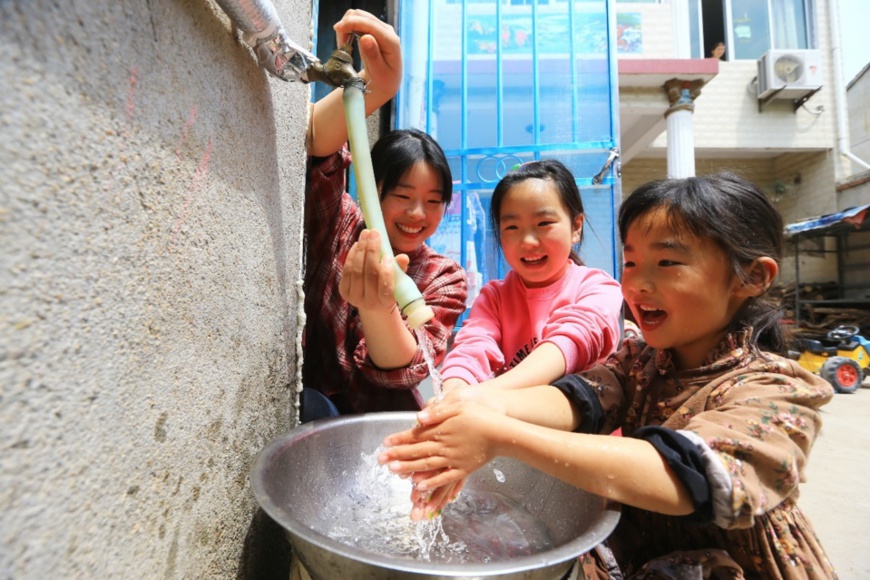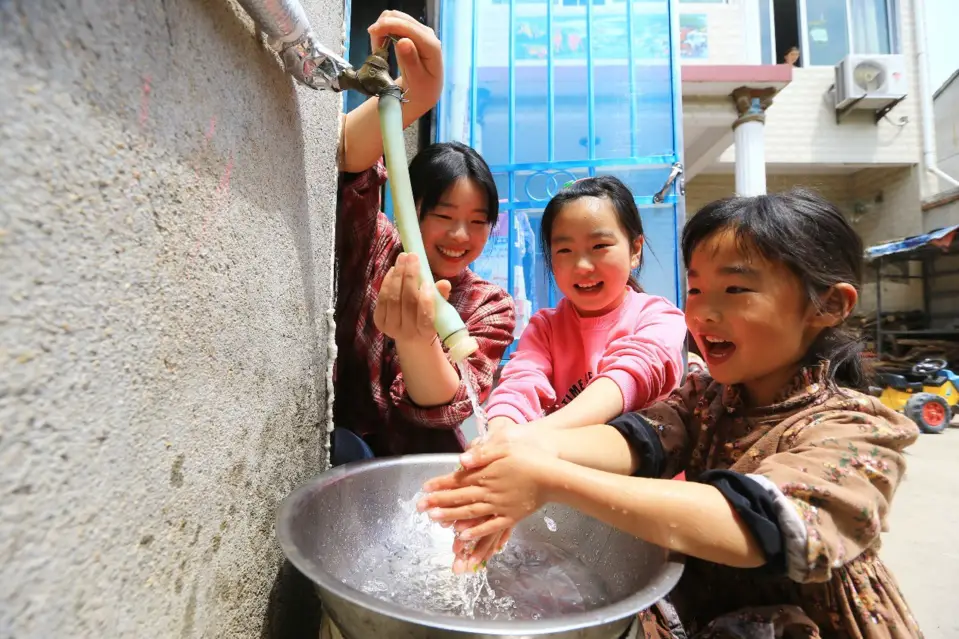By Wang Hao, People’s Daily

Local families in Shenxu village in Linhuan township, Suixi county, Huaibei, east China’s Anhui province, have access to tap water, April 23, 2020. (Photo by Wan Shanchao/People’s Daily Online)
Many villagers in remote rural areas of Tongshan district, Xuzhou, east China’s Jiangsu province, like Xiezhuang village and Shalou village, suffered difficulty in getting safe drinking water for generations and sometimes even had to drink water with high fluoride content and bitter and salty water.
“Instead of asking about the GDP growth, local villagers were much more concerned when they could have access to the same drinking water as that enjoyed by urban residents,” recalled Wang Weifeng, secretary of the Communist Party of China (CPC) Tongshan district committee.
Fortunately, such sad experience was all ended for good in 2018, thanks to the completion of an integrated rural and urban water supply project.
Today, people in Tongshan district are enjoying high-quality water from the same sources and the same network as residents in downtown Xuzhou.
In an effort to guarantee safe drinking water for rural areas, Tongshan district has input a total of 1.2 billion yuan (about $173.88 million) in the integrated rural and urban water supply project, which covers more than 1,000 villages in over 20 townships and has pipelines spreading 12,000 kilometers.
As a matter of fact, Tongshan district is not the only area in China that has resolved the problems blocking people’s access to safe drinking water. Similar achievements have been witnessed across the country over the past years.
Located at the eastern reaches of Horqin grassland in north China’s Inner Mongolia autonomous region, Tongyu county in Baicheng, northeast China’s Jilin province, suffered from severe drinking water problem as it sees an average annual precipitation of only 350 millimeters and the underground water in the county is generally undrinkable because of excessive content of fluorine, iron, and manganese.
By the end of 2019, Tongyu county had solved drinking water safety problems troubling its rural areas and guaranteed people’s access to 100 percent qualified drinking water by building 655 centralized water supply facilities in the county, with the water supply network stretching for 4.54 million meters.
On May 20, 2020, the urban and rural safe drinking water project of Payzawat county, Kashgar prefecture, northwest China’s Xinjiang Uygur autonomous region, was put into use.
Consisting of three major parts covering drawing, transportation, and distribution of water and with a total investment of nearly 1.75 billion yuan, the project includes a main waterworks with a daily handling capacity of 85,000 cubic meters, and 17 newly built, transformed, or extended branches. It represents the greatest amount of investment in China’s domestic water safety projects so far.
With the completion of the project, the 15,300 impoverished people in Payzawat county have got access to safe drinking water, marking a historic moment when all poor people in Xinjiang were freed from bitter and salty water forever and guaranteed safe drinking water.
Drinking water safety in rural areas has always been regarded as an important and major undertaking of the Chinese government.
By the end of July, China had improved the level of water supply safety for 256 million of its rural residents, resolving problems hindering drinking water safety for 17.1 million impoverished population, according to a press conference held by the State Council Information Office on August 21.
China has completely resolved the drinking water safety problems for its poor population in terms of the current standard.
China’s Ministry of Water Resources will then focus on consolidating the fruits of the country's poverty alleviation campaign and further enhancing water supply safety in rural areas, said Chen Mingzhong, an official with the Ministry of Water Resources.
Efforts should be made to find out leftover problems and improve weak links in relevant projects, with priority being given to those areas that have not shaken off poverty, Chen said.
For counties that have already got rid of poverty, monitoring and troubleshooting should be enhanced so as to prevent recurrence of old problems, Chen noted.
The country should also establish a long-term mechanism for operation, management, and maintenance of relevant projects, assign responsibilities for management of these projects and materialize funding for maintenance of these projects, as well as improve and perfect its emergency water supply plan, he added.
“Instead of asking about the GDP growth, local villagers were much more concerned when they could have access to the same drinking water as that enjoyed by urban residents,” recalled Wang Weifeng, secretary of the Communist Party of China (CPC) Tongshan district committee.
Fortunately, such sad experience was all ended for good in 2018, thanks to the completion of an integrated rural and urban water supply project.
Today, people in Tongshan district are enjoying high-quality water from the same sources and the same network as residents in downtown Xuzhou.
In an effort to guarantee safe drinking water for rural areas, Tongshan district has input a total of 1.2 billion yuan (about $173.88 million) in the integrated rural and urban water supply project, which covers more than 1,000 villages in over 20 townships and has pipelines spreading 12,000 kilometers.
As a matter of fact, Tongshan district is not the only area in China that has resolved the problems blocking people’s access to safe drinking water. Similar achievements have been witnessed across the country over the past years.
Located at the eastern reaches of Horqin grassland in north China’s Inner Mongolia autonomous region, Tongyu county in Baicheng, northeast China’s Jilin province, suffered from severe drinking water problem as it sees an average annual precipitation of only 350 millimeters and the underground water in the county is generally undrinkable because of excessive content of fluorine, iron, and manganese.
By the end of 2019, Tongyu county had solved drinking water safety problems troubling its rural areas and guaranteed people’s access to 100 percent qualified drinking water by building 655 centralized water supply facilities in the county, with the water supply network stretching for 4.54 million meters.
On May 20, 2020, the urban and rural safe drinking water project of Payzawat county, Kashgar prefecture, northwest China’s Xinjiang Uygur autonomous region, was put into use.
Consisting of three major parts covering drawing, transportation, and distribution of water and with a total investment of nearly 1.75 billion yuan, the project includes a main waterworks with a daily handling capacity of 85,000 cubic meters, and 17 newly built, transformed, or extended branches. It represents the greatest amount of investment in China’s domestic water safety projects so far.
With the completion of the project, the 15,300 impoverished people in Payzawat county have got access to safe drinking water, marking a historic moment when all poor people in Xinjiang were freed from bitter and salty water forever and guaranteed safe drinking water.
Drinking water safety in rural areas has always been regarded as an important and major undertaking of the Chinese government.
By the end of July, China had improved the level of water supply safety for 256 million of its rural residents, resolving problems hindering drinking water safety for 17.1 million impoverished population, according to a press conference held by the State Council Information Office on August 21.
China has completely resolved the drinking water safety problems for its poor population in terms of the current standard.
China’s Ministry of Water Resources will then focus on consolidating the fruits of the country's poverty alleviation campaign and further enhancing water supply safety in rural areas, said Chen Mingzhong, an official with the Ministry of Water Resources.
Efforts should be made to find out leftover problems and improve weak links in relevant projects, with priority being given to those areas that have not shaken off poverty, Chen said.
For counties that have already got rid of poverty, monitoring and troubleshooting should be enhanced so as to prevent recurrence of old problems, Chen noted.
The country should also establish a long-term mechanism for operation, management, and maintenance of relevant projects, assign responsibilities for management of these projects and materialize funding for maintenance of these projects, as well as improve and perfect its emergency water supply plan, he added.
 Menu
Menu
 Drinking water safety problems completely resolved for China’s poor population
Drinking water safety problems completely resolved for China’s poor population
















